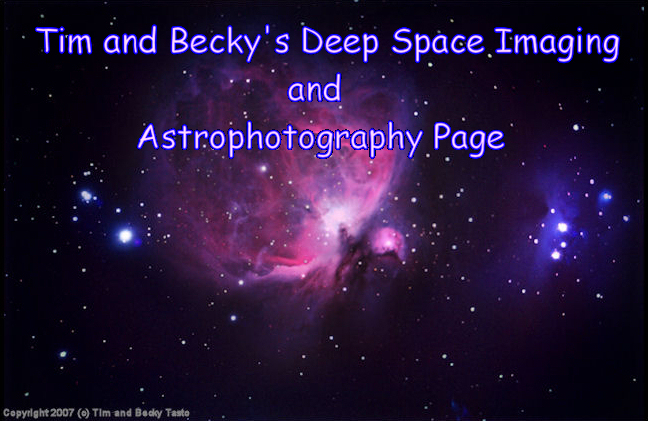|
 Last update 10/16/22. Optimized for viewing at 1280 x 768 resolution. Latest News:
These web pages are moving to www.timtasto.com in October of 2022. Please go there and update your bookmarks accordingly. Thanks! ----------------------------------------------------------------------------------------------------- Local Scientist and his Team Make Discovery at CSB/SJU Observatory! 1) Dr. Thomas Kirkman, along with a group of undergraduate researchers at the St. Johns University Observatory, have made an important discovery involving variable star TYC 1031 1262 1 (aka ASAS J182611+1212.6) in the constellation of Hercules. The star is cataloged as a "Cepheid" variable, and as such, it is expected that it's brightness would vary with a regular period. The research into this particular star is complicated by the fact that the star is both an intrinsic variable (the star itself pulsates), and it is also being eclipsed periodically by another (dimmer) star as part of a binary system. Following years of data gathering using one of the telescopes and imaging systems at the CSB/SJU observatory, and via comparison with previous data, it was discovered that the star in question is exhibiting an oscillating period. This is unusual for this type of variable star, and it will take further analysis to determine the reason for such surprising behavior. The discovery was presented at the 230th meeting of the American Astronomical Society, which was held back in June 2017 in Austin, Texas. My congratulations to Dr. Kirkman and his team of undergraduate students for their contributions to the world of science! If you would like to know more, the link below will open a .pdf file located on the csb/sju website. The file contains detailed information on the study of the star and methodology employed in measuring it's period, along with credits to the students who participated (B. Demarais, M. Ellis, D. Byrne, J. Benson, J. Hoppert, and A. Lusty): http://www.physics.csbsju.edu/ccd/2017AAS.230.217.03K.pdf Enjoy! ---------------------------------------------------------------------------------------------------------------------------------------------------------------- 2) Some of our SAC-8 series images have been published in a book titled "Introduction to Webcam Astrophotography" by technical author Robert Reeves and sold by noted publisher Willman-Bell. Robert did a great job on the book but I won't elaborate here. Please check out the Willmann-Bell website and pay a visit to Robert's excellent site as well. 3) I have created a simple image processing tutorial to provide a starting point for those who want to get an idea of how the process works in simple terms. 4) If you are interested in 3D modeling, please check-out the "Other Stuff" link (above right button). I have added some information and images regarding architectural visualization using the Blender 3D modeling program, as well as Punch! Home and Landscape Design (Pro) software. Introduction: Welcome to the deep space astrophotography pages of Tim Tasto and Becky Tasto. The images on these pages are largely of galaxies and nebulae (Messier and NGC objects) that are hundreds and even millions of light years distant. We obtained these images using a variety of telescopes and digital imaging devices (i.e. we no longer use film). The images are grouped as such in the links provided. Our primary imaging site is our backyard or driveway at our home in central Minnesota. The light pollution is quite severe and growing worse but the use of digital imaging devices (CCD and DSLR) with computers allows us to obtain reasonable astroimages of deep space objects despite the heavy glow from the city and streetlights (see image of M42 above). The image of M42 above (The Orion Nebula) was captured from our back-yard using a Meade 8-inch LXD55 SN with an unmodified Canon Digital Rebel XTi DSLR. The actual image is quite large at nearly 3800 pixels wide (way too big for this web page). The number of color images we have taken is still limited to only a few, but If you like color images, follow our link to the Canon Digital Rebel XTi page. As noted on the web page of another astrophotographer, the pursuit of astroimaging (or astrophotography) is surprisingly difficult as it is both physically demanding and has a steep learning curve. But, despite the difficulty (or perhaps because of the difficulty) in obtaining these images, the rewards are great. If it were not difficult, maybe it would not be worth doing. Please scroll through the links provided above to see a variety of astronomical images taken (mostly) from our home using CCD (SBIG / SAC) and CMOS (Canon Digital Rebel XTi) devices. The images largely include galaxies, nebula and star clusters. Telescopes:
We typically do not autoguide, but have occasionally done so with the SBIG ST-7e device, which has a built-in autoguiding chip. Most of our images are manually guided. Clear Sky Clock from St. Johns University: Click on bar-image below for tonights projected seeing conditions: Email us: dsastro <at> cloudnet <dot> com
Replace the <at> with @. Replace the <dot> with a period. Please include the word "astrophotography" or something similar in the subject of your e-mail or it may be mistaken for SPAM and deleted. Site Map NOTE:
Some of the content on these web pages has been used for commercial
purposes with our permission. Please note that all images on these
pages are Copyright (c) Tim and Becky Tasto. Please
e-mail us if you wish to discuss permissions for your
(commercial) use of any content. This not only protects our work,
it is also beneficial to you because if you would like to use any
content, we could likely send you BETTER quality images and/or
information than by just downloading content from these pages
(as most of the images on these pages are ".jpg" and very small in
order to reduce memory use on my web-page account) . |
|
||||||||||||||












